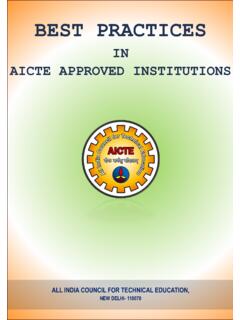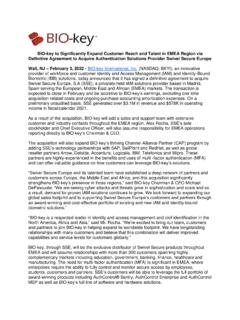Transcription of Waste to Resources
1 A Waste Management HandbookWaste to ResourcesWaste to Resources :A Waste Management Handbookii The Energy and Resources Institute, 2014 All rights reserved. No part of this publication may be reproduced, stored in a retrieval system, or transmitted in any form or by any means, electronic, mechanical, photocopying, recording or otherwise, without the prior permission of the byTERI PressThe Energy and Resources Institute Tel. 2468 2100 or 4150 4900 Darbari Seth Block Fax 2468 2144 or 2468 2145 IHC Complex, Lodhi Road India +91 Delhi (0)11 New Delhi 110 003 E-mail Website DisclaimerThe views and opinions expressed in this compilation are those of the authors and do not necessarily reflect the official policy or position of The Energy and Resources Institute (TERI). The analyses performed within this publication are only examples of such applications by various industry participants.
2 Assumptions made within the analysis are not reflective of the position of TERI or TERI-BCSD or any government or any private entity. This compendium is only a compilation of the aforementioned data in the form of case studies sent by officials from the organizations that participated in this exercise. TERI or TERI-BCSD does not claim the reliability of the content published as a part of the compendium. Circulation of this publication or any data related to it is not permitted without the consent of the in India iiiContents Foreword ..vAcknowledgements ..viiParticipating Companies ..ixIntroduction ..1 Classification of Waste ..3 Evolution of Laws ..9 Technology Factsheet ..15 Integrated Solid Waste Management ..40 Case Studies ..451. Reduction of Industrial Waste Generation by Proper Handling and Management of Waste Materials ..472. Reduction of Industrial (Non-Hazardous & Hazardous) Waste Generation.
3 493. Municipal Solid Waste and Hazardous Waste Management by Polycrack Technology & CFL Crusher ..534. E- Waste Management Take Back & Recycling ..575. E- Waste & Hazardous Management ..616. Integrated Municipal Solid Waste Management ..637. Great Giant Pineapple: Soil Health Management ..678. Waste Management ..709. Sintesa Group: Optimizing Waste of Natural Gas in Fulfilling Electricity Demand ..73 References ..75vForewordThe growing urbanization and pursuit for faster economic development need, particularly in growing economies, are leading to unprecedented growth in all kind of wastes municipal including e- Waste , and industrial hazardous and non-hazardous wastes. The cities in developing economies have also been witnessing a growing amount of sewage, large portion of which is discharged untreated in water bodies and thus, is largest source of their pollution.
4 While the countries in Europe and countries like Japan in Asia have been successful in maximizing resource recovery and Waste recycling and thus diverting Waste from landfills, the cities in developing economies have been still struggling with source segregation of Waste and setting up material recovery and Waste recycling facilities, and most of the Waste still is reaching the landfill sites. As most of these landfill sites in developing economies unlined low-lying areas. Waste disposal at such sites result in contamination of surface and groundwater sources making them unfit for human consumption. Experiences in developed countries in past have shown that cleaning up contaminated sites has been much more expensive than implementing pollution prevention strategies. It is expected that global Waste management cost which at present is whopping $ billion annually will increase to $ billion in 2025 thus, putting a lot of pressure on agencies managing these wastes.
5 Also as the cities are growing exponentially, they are facing problem in locating and developing Waste disposal sites. The availability of suitable land for Waste disposal is becoming a challenge for urban local bodies. Hence, there is a need to urgently look for Waste reduction, reuse and recycle (`3) not only to ensure material recovery, but also to reduce the need for landfills. Enhanced material recovery also ensures resource security in terms on lesser dependence on virgin Resources . This guidebook titled Waste to Resource provides a detailed overview of urban liquid and solid Waste management, construction and demolition debris management, industrial liquid and solid Waste (including hazardous and non-hazardous Waste streams) management, biomedical Waste management in healthcare facilities and e- Waste management.
6 The section in the guidebook also deals with the evolution of Acts and Rules in India that deal with pollution control and Waste management. It provides a snapshot of some of the recent Rules dealing with Waste last section of the guidebook provides technology fact sheet covering useful Waste treatment and processing technology options, which can not only control pollution, but also ensure maximizing resource recovery from Waste . I commend TERI-BCSD for their efforts to research and compile a guidebook on this complex but topical issue. I am sure the information provided in the guidebook will be useful to Waste management practitioners and help them manage their Waste in an environmentally sound manner. Dr. Suneel PandeyAssociate Director, TERIviiAcknowledgementsThe Waste to Resources : A Waste Management Handbook was developed with the active engagement and support of the Waste Management working group of the CSO (Chief Sustainability Officers ) Forum and other leading companies who contributed to the creation of this compendium by sending in the best practices followed in their esteemed organizations.
7 This guidebook strives to acknowledge and appreciate some organizations that have championed Waste Management practices Implementation in India. We would like to thank our working group companies to have come forward to develop this important guidebook that encourages other businesses to learn from the industrial best practices in mainstreaming sustainability across their business practices. This guidebook has benefited greatly from a highly engaged set of thought leaders from the industry and beyond. We would like to acknowledge the contribution of the following individuals (arranged in alphabetic order of the first name):Mr A K Sakalker, Bharat Petroleum Corporation LtdMr Anuj Mishra/Ms Humsa Dhir, Akzo Nobel India LtdMs Ashima Sushilchandra/Mr Thyagarajan, BASF India LtdMr Avinash Patkar, TQMSMs Beroz Gazdar, Mahindra & Mahindra LtdMs Chaitanya Kommukuri, YES Bank LtdMr Ganesh Chandra Tripathy, Jubilant Life Sciences LtdMr J S Bhatia, Bharat Petroleum Corporation LtdMr Jasraj Virdi, CLP India Pvt.
8 LtdMr K K Verma, NTPC LtdMr Krunal Negandhi, Lavasa Corporation LtdMr L Rajan, State Bank of IndiaMr Manoj Kumar Singh, Indus Towers Pvt. LtdMs Namita Vikas, YES Bank LtdMr Naresh Patil, Mahindra and Mahindra LtdMs Niyati Sareen, HCC LtdMr P S Narayan, WIPRO LtdMr Pramod Natuvetty, AkzoNobel India LtdDr Prasad Modak, IL&FSMr Rakesh Bhargava, Shree Cements LtdMr Santanu Kumar Satapathy, CLP India Pvt. LtdMr Shubhenjit Chaudhari, TATA SteelMr Srinath Komarina, YES Bank LtdMr Ulhas Parlikar, ACC Pvt. LtdTERIMr Dipankar SanyalDr Suneel PandeyMs Radhika KapoorMs Smriti BhatnagarMr Sumit PrasadMr Pawan Garg Ms Mansi Gupta Mr Santosh Gautam Ms Shilpa Mohan Mr Aman Sachdeva ixParticipating Companies1 Waste has always been a perennial problem and its management remains a big predicament up to this day, since the amount of solid Waste increases as populations rise and economies develop.
9 Today, the total amount of Waste generated annually worldwide (municipal, industrial, hazardous) is more than 4 billion tonnes, the municipal solid Waste is between to billion tonnes. [1] Also, the global impacts of solid Waste are growing fast as solid Waste management costs will increase from today s annual $ billion to about $ billion in 2025. [2] Basel Convention by UNEP define wastes as substances or objects, which are disposed of or are intended to be disposed of or are required to be disposed of by the provisions of national law . Our daily activities give rise to a large variety of different wastes arising from different sources. Cleaning up of Waste contamination is much more expensive in the long term as compared to its prevention at source. Countries are facing an uphill challenge to properly manage their Waste with most efforts to reduce the final volumes and generate sufficient funds for Waste management.
10 Waste management is needed for these countries which is the joint responsibility of the Citizens, Industries, the local governments and the pollution control boards. Waste management comprises a collective activity involving segregation, collection, transportation, re-processing, recycling and disposal of various types of wastes. Different wastes and Waste -management activities have varying impacts on energy consumption, methane emissions, carbon storage, ecological and human health. For example, recycling reduces greenhouse gas emissions by preventing methane emissions from landfills or open dumps and preventing the consumption of energy for extracting and processing raw materials. Improper Waste Management is one of the main causes of environmental pollution. The World Health IntroductionOrganization (WHO) estimates that about a quarter of the diseases faced by mankind today occur due to prolonged exposure to environmental pollution.


